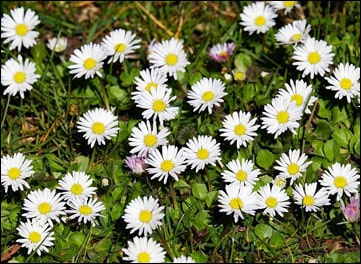What are the Uses and Health Benefits of Common Daisy (Bellis perennis)?

- Common name – Daisy
- Botanical name – Bellis perennis
- Hindi name – Gulbahar, Gulabahaar
- Family – Asteraceae
Bellis perennis is a member of Asteraceae family and most common species of the daisy genus. Although many similar plants share the daisy name but this one is more common, popular and possess more medicinal properties than the others. So just to differentiate it from others, this plant is also given names like Common daisy, English daisy and Lawn daisy. Owing to the medicinal properties this plant possesses, woundwort and bruisewort are the other names given to it. Bellis perennis is used in many alternative systems of medicines for treating injuries and bad effects of injuries. This plant is native to Northern, Western and Central Europe, but it is also grown widely in most of the temperate regions. America and Australia are other places where this herb can be found to be growing widely.
General Description
Bellis perennis is the perennial herbaceous plant that possess small and rounded rosettes and short creeping rhizomes. Its leaves are 2-5cm long, growing flat on the ground. Common daisy is considered to be invasive weed and called lawn daisy due to its quality of growing widely in lawns where it becomes hard to remove from the place where they grow.
Cultivation
This plant blooms from early summers to midsummer. But if the conditions present are ideal for the growth of common daisy, its flowering season lasts for several months. It can grow from full sunlight to partial shade conditions and the best thing about this plant is that they require low or even no maintenance. Bellis perennis has no disease or insect issues and can be grown well in properly drained soils.
Habitat
Bellis perennis is native to Western Asia and Europe, but has been naturalized through the world due to its growing popularity and wildly growing property. This plant grows well in nutritious and moist soil. Common daisy can be found growing commonly in garden, parks, roadsides, meadows, and cemeteries. However some people consider it to be a problematic plant because of its invasive property.
Parts Used
Usually the head of the freshly dried flowers are used for the medicinal purpose. However, its leaves can also be sometimes used.
Medicinal Properties of Common Daisy
- Anti-inflammatory
- Astringent
- Digestive
- Antispasmodic
- Healing
- Laxative
- Purgative
- Antispasmodic
- Antitussive
- Demulcent
- Emollient
- Expectorant
- Tonic
Health Benefits of Bellis perennis
- It is mainly used in the homeopathic system of medicine as a medicinal remedy for healing the wounds after surgery.
- Bellis perennis heals the wound due to the astringent and demulcent properties that are possessed by this herb.
- Anti-inflammatory and stringent properties help to treat bronchitis, coryza and other inflammatory conditions of the upper respiratory tract.
- Stimulating action of the herb on digestive tract helps to treat loss of appetite.
- Liver and gall bladder ailments can also be treated by Bellis perennis, owing to this therapeutic action.
- Painful menstruation has been treated by common daisy since long time back. It is because of the antispasmodic action of the herb on uterus and its muscles.
- Cystitis and other urinary tract’s inflammatory conditions are treated successfully by Bellis perennis.
- Also as one of its names suggests, bruisewort, it is used as a natural remedy for treating bruising. External application and internal application both can help in it.
- It is a very good remedy for the mouth sores and sore throat. In these cases, the mouthwash made from juice, that is extracted from it’s leaves and flowers of the plant is used. Gargling with the decoction of its leaves and chewing the leaves can also help in it.
- Constipation is relieved by this plant, as it possesses natural laxative and purgative qualities.
- Certain studies suggest the curative action of the Bellis perennis in eczema. Intake of strong decoction of the roots is suggested for this purpose.
- Mild decoction made from its leaves can help in problems related to menstruation, respiratory tract and rheumatic pains.
Other Uses of Bellis perennis
- Other than medicinal uses, there are many other uses of this plant. Raw leaves of common daisy can be eaten in salads.
- It can also be cooked and eaten.
- Petals of the flower can also be eaten raw in salads, sandwiches and soups.
- Herbal tea made from its petals is much popular and due to the high vitamin content, it can be used as a supplement.
Side Effects of Common Daisy
- No herb should be used without the supervision of any herbalist or Ayurvedic doctor, as it may result in danger to the health.
- However, no specific side effects of the common daisy is seen when the herb is used properly.
- Although, people allergic to plants of Asteraceae should avoid its usage.



